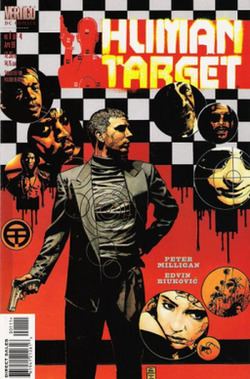Schedule Monthly Publisher Vertigo | Main character Christopher Chance | |
 | ||
Format Mini-seriesGraphic novelOngoing series Publication date mini-series April 1999 – July 1999Final Cut May 2002ongoing October 2003 – June 2005 Number of issues mini-series 4Final Cut 1ongoing 21 Similar Greek Street, Deadenders, Crossing Midnight, JLA/Cyberforce, American Virgin | ||
Human Target is an espionage-related comic series written by Peter Milligan and published by the Vertigo imprint of DC Comics. The series was based on the Human Target character created in 1972 by Len Wein and Carmine Infantino. The original Vertigo miniseries yielded an original graphic novel and later, an ongoing series.
Contents
Mini-series
Christopher Chance, alias the Human Target, was a back-up feature created for Superman's title Action Comics comics in the 1970s. In 1999, writer Peter Milligan and artist Edvin Biuković revived the character for the Vertigo imprint with a four-issue limited series. Human Target #1–4 saw Chance assaulted by an assassin, the end product of which was the loss of his face. While dealing with painful and lengthy reconstructive surgery, Chance uses his assistant, Tom McFadden, to impersonate him and draw out the assassin while protecting a Los Angeles reverend, which leaves all involved tormented both physically and mentally.
Final Cut
With the success of the limited series, Milligan returned to Christopher Chance in 2003 with the publication of an original graphic novel, Human Target: Final Cut, for which Milligan was joined by artist Javier Pulido. Chance, still reeling mentally from the aftermath of the previous limited series, works with a Hollywood family to save their missing celebrity son. Ultimately Chance fails in his mission, but adopts the guise of the boy's father, going so far as to have permanent reconstructive surgery to take on this, his final role. By doing so, Chance finds something he's never had before, a quiet life with a woman who loves him.
Ongoing series
Chance returned in an ongoing series later in 2003, also published under the Vertigo imprint. The series was again written by Peter Milligan, and illustrated by Javier Pulido and Cliff Chiang.
With his deceptions following Final Cut discovered, Chance leaves behind Los Angeles to move to New York City, taking on a variety of jobs that test him physically and mentally, as he explores the psychological cost of becoming someone else. The series, which lasted 21 issues, closed with the three-part arc, "The Stealer," which features the return of Tom McFadden, who has decided only one identity will keep him sane—that of Christopher Chance. The only problem is that the real Chance is in the way.
Collected editions
Several trade paperbacks of the series were released:
